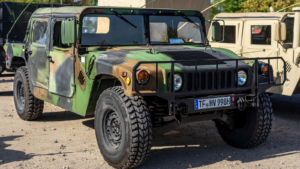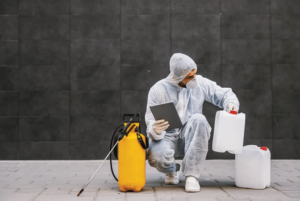At the height of the Iraqi insurgency, US troops traveling in Humvees were dying at an alarming rate from IED attacks. Bolting on extra armor increased the vehicles’ protection, but added weight made them slow, clumsy, and prone to rollovers.
The Army wants a vehicle combining the Humvee’s off-road capabilities with the MRAP’s unrivaled protection. Oshkosh Defense beat out Lockheed Martin Corp and Britain’s BAE Systems to win the lucrative contract for the new Joint Light Tactical Vehicle. Click the Humvee Interior to learn more.

The Humvee is one of the most recognizable pieces of military hardware ever produced. Its use in the 1991 Gulf War and the ongoing War in Afghanistan have made it synonymous with modern conflict. However, its legacy stretches far beyond these conflicts. Its ruggedness and iconic design have led to its popularity outside of the military, with off-road enthusiasts, emergency services, and even celebrities all relying on modified versions of the vehicle for their needs.
The story of the Humvee began in Vietnam, where the Army’s fleet of jeeps were pushed to their limits by the demands of modern weapon systems. By 1979, it was clear that an upgrade was needed, and so the Army issued a request for proposals for a new workhorse. AM General, Chrysler Defense and Teledyne Continental all submitted prototypes, and by 1981 the Army had chosen AM General’s High Mobility Multipurpose Wheeled Vehicle, better known as the Humvee.
Designed as a replacement for the Jeep, the Humvee has since become the world’s most versatile light military vehicle. It can be adapted for a variety of missions, and its chassis is easily modified to accommodate everything from mounted machine guns to wire command-guided antitank missile launchers. It can be customized to suit almost any terrain, from desert to jungle, and is capable of operating for long periods with minimal maintenance.
While the Humvee’s off-road capabilities have earned it a reputation as a “war machine,” the fact is that its primary mission is transporting soldiers and cargo to and from the frontline. As such, it has a number of significant weaknesses, particularly when faced with the kind of deadly, roadside ambush that was commonplace in Iraq.
As a result, the Army has begun to move away from the Humvee in favour of vehicles that are more heavily armoured. But the Humvee is a tried and tested platform that will continue to fulfil its critical role for decades to come. With the JLTV gradually replacing it in frontline battle roles, and the upcoming SABER offering an improved version of the original HMMWV for an affordable price, the Humvee’s legacy looks safe for some time to come.
The Humvee’s design
Designed to meet the needs of the Army, Marines, and Air Force, the Humvee is a formidable machine. Its boxy four-wheel drive chassis straddles a wide platform, and it holds a payload of 2,500 pounds in combat conditions—more than double that of a jeep’s. It can also mount a mix of weapons, from machine guns and grenade launchers to the a deadly TOW antitank missile, usually launched from helicopter gunships. A clever pop-up gun turret gives the Humvee added firepower in combat, while an armored shell protects the crew from enemy fire and shrapnel.
The Army kept adding armor and other protective features to the vehicle as it entered Iraq and Afghanistan. While these added luxuries protected the personnel inside, they came at a price: the increased weight made the Humvee slow, clumsy, and prone to rollovers. The extra strain on the engine, transmission, and drivetrain accelerated wear and led to frequent mechanical failures.
In recent years, the military has begun to shift its focus toward the future, replacing many of the Humvee’s current roles with newer platforms like the Joint Light Tactical Vehicle (JLTV). But despite the emphasis on the next generation, the Humvee will remain part of the service’s fleet for decades to come.
The vehicle’s iconic look will not change much in the future. But the technology within will evolve, as the Army aims to make the vehicle more fuel efficient and reduce its reliance on foreign oil. To accomplish this goal, the military is testing out a hybrid electric-drive Humvee called the HUMVEE Charge, which uses commercial-off-the-shelf components to integrate an internal combustion engine with an electric motor. The combined system provides both the performance of a traditional ICE and the energy efficiency of an electric drivetrain. The resulting vehicle can run on either electric or gasoline power—and is capable of traveling longer distances without refueling. Check out the video below to see the HUMVEE Charge in action.
The Humvee’s capabilities
The Humvee can be adapted to a number of different configurations. For example, it can be converted into a cargo vehicle, troop carrier or field ambulance. The Humvee is also capable of mounting a gun turret, which can be outfitted with either a machine gun or Mark-19 automatic grenade launcher. As a result, the Humvee is one of the most versatile vehicles in the US Army’s inventory.
The military’s initial requirements for what became the Humvee were quite demanding. These included the ability to climb a 60 percent incline, traverse a 40 percent slope and ford 2.5 feet of water. As a result, the Humvee has a robust four-wheel drive system and impressive offroad capabilities.
In addition to its offroad capabilities, the Humvee can also function as a mobile command post. It can carry sophisticated communications and detection equipment, which allows it to communicate with both friendly and hostile forces on the battlefield. This can be crucial when trying to locate and destroy enemy combatants.
Another important capability of the Humvee is its ability to withstand enemy attack. The vehicle is designed with a special armour that can withstand both small arms fire and 16-grain ballistic fragments traveling at 1,400 ft. per second. The Humvee’s armor is also designed to protect its crew from mines and other explosive devices that might be thrown at the vehicle during combat.
Humvees are also designed to require minimal maintenance, which can save the Army time and money. They are equipped with an automatic transmission, which is easier for soldiers to use than a manual gearshift. In addition, they are built with run-flat tires, which allow the vehicle to continue moving if a tire is punctured.
While the Humvee is a very effective vehicle, it does have some drawbacks. For one, it is not very fuel efficient. In fact, the Humvee consumes more fuel than a Jeep, which is a much smaller and lighter vehicle. The Humvee also has a tendency to overheat, which can be a serious problem in hot weather. As a result, the Army has begun developing new variants of the Humvee that will address these problems.
The Humvee’s problems
When it comes to rugged off-road vehicles, the Humvee reigns supreme. With a 6000 durability rating, the HMMWV can shrug off everything from accidents to bullets from Cultists and T-Dolls with little effort. But that ruggedness can also be its downfall. If a Humvee were to hit an IED or landmine, the occupants may not survive. That’s why it’s essential to outfit your Humvee with proper armor and protection.
The Humvee was originally created to replace the Army’s fleet of jeeps, which were becoming increasingly outdated. But it soon became clear that the new vehicle would need to be larger in order to accommodate new weapons and equipment. The Army came up with some specs, including a diesel engine and an automatic transmission, and AM General got to work. The result was the Humvee, which debuted in 1984 and saw its first action in Panama five years later.
Although the Humvee thrived in peacetime, it suffered mightily during the wars in Iraq and Afghanistan. Insurgents began targeting US troops with improvised explosive devices, which quickly proved to be a deadly threat. While reinforced armor and improved bomb-resistant technology were used to improve the vehicle’s capabilities, the Humvee was still prone to attack from buried explosives.
To reduce the number of soldiers killed in Humvee crashes, the Pentagon replaced the Humvee with a more heavily armored vehicle known as the MRAP. But the MRAP is massive and can be difficult to maneuver, which may make it less useful than its predecessor. Additionally, the MRAP is often overloaded with weapons, turrets, and other modifications, which increases the risk of injury to the occupants.
A new study from the Johns Hopkins Center for Injury Research and Policy finds that there are several factors that increase a soldier’s risk of injury while in a Humvee. Among the most important factors are being involved in combat or serving as the vehicle’s driver or gunner. This finding suggests that training for military personnel on how to operate their Humvees in combat-like settings might be beneficial. In addition, the study recommends improving the design of military vehicles and increasing their availability for civilian use.

